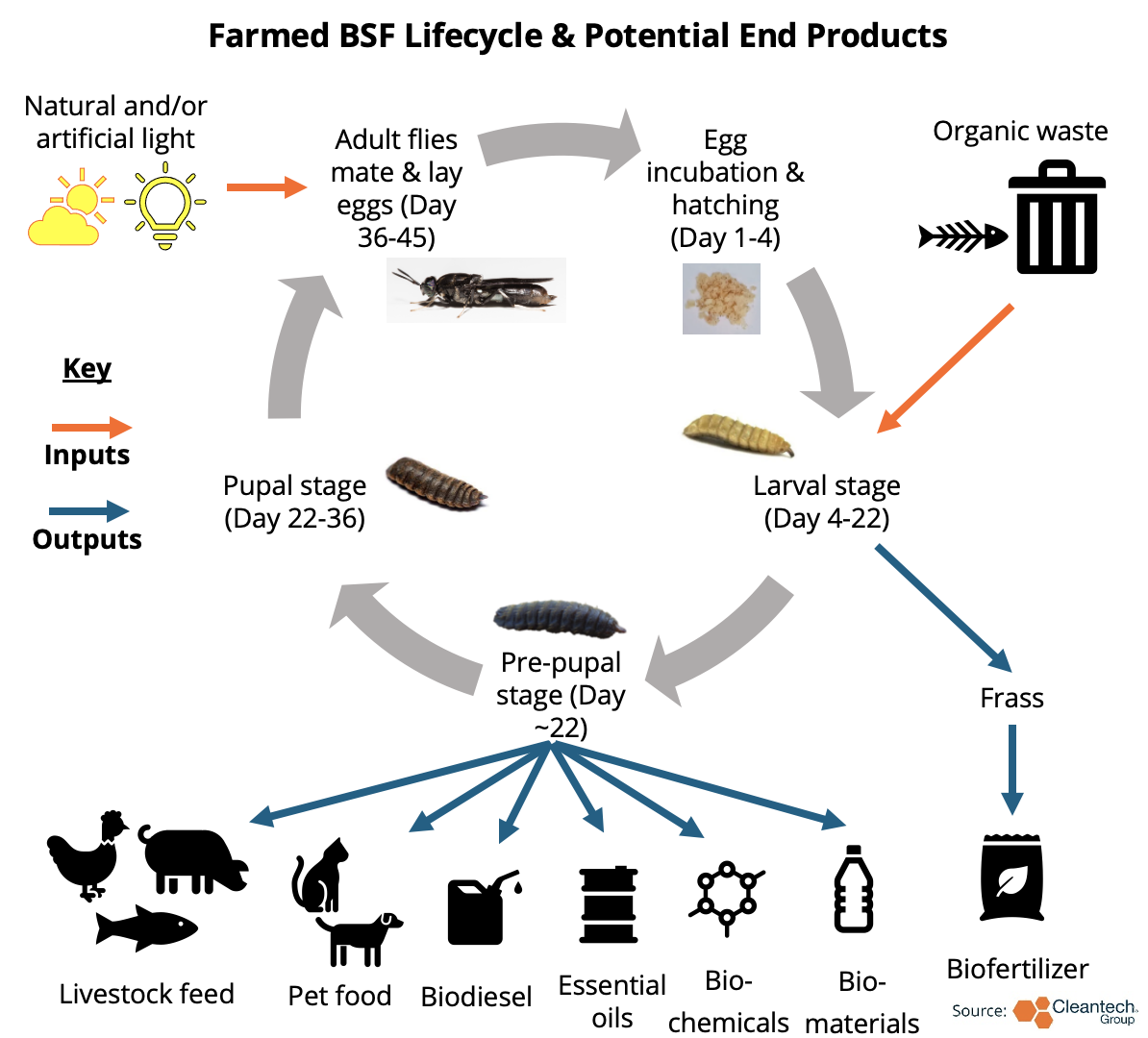There was a time, not so long ago, when insects were being touted as the solution to food’s emissions problem. The logic went like this: If we all switched from eating cows and sheep to eating bugs and grubs, then we’d eliminate much of the massive methane footprint of livestock agriculture while also handily finding a way to upcycle the sector’s vast amount of organic waste.
However, the market for human consumption remains negligible due to cultural barriers, perceptions around hygiene and safety, and regulatory challenges.
Despite these hurdles, the vast majority of farmed insect biomass today is used as animal and aquaculture feed, with significant growth potential in niche markets such as industrial chemicals, biofuels, waste management, and pet food.
Key Benefits of Insect Farming
Insect farming offers several advantages over conventional livestock:
- Higher Feed Conversion Ratio: Insects convert feed into protein more efficiently than traditional livestock, using a fraction of the land and water resources.
- Circularity: Farmed insects can often be fed exclusively on organic waste streams, including byproducts from the agri-food industry.
- Rapid Growth: As an example, black soldier fly larvae mature quickly, with 1kg of larvae yielding 0.5kg of protein in just 2-3 weeks.
- Location Flexibility: Insects require less space and can be reared in controlled environments, allowing bioconversion to be located near waste streams.
Key farmed species are black soldier fly (BSF) larvae, darkling beetle larvae (mealworms), and various types of crickets.

Emerging Niche Markets
Currently, about 95% of farmed insect biomass is used as feed for animals and aquaculture. This market is driven by the need to replace problematic feed components like fishmeal and soymeal with more sustainable options. Although insect-based feed is slightly more expensive, it can be marketed as a semi-premium product due to its nutritional and environmental benefits.
While we can expect feed to remain the primary destination for insect biomass, there is significant growth potential in markets such as industrial chemicals, biofuels, waste management, and pet food.
The latter shows particular promise in the near term, accounting for 20-25% of all meat produced, with a market value of $121B in 2023. Pet owners are willing to spend relatively highly for their furry family members, who also have the distinct advantage of being less discerning than their humans when it comes to what goes into their food.
- Pet Food: A growing market with regulatory approvals in key jurisdictions.
- Human Health and Nutrition: Mixed prospects, though fats, oils, and growth factors for alternative meat production are notable areas.
- Agricultural Inputs: Frass (insect droppings and castings) can be processed into soil amendments and biofertilizers.
- Specialty Compounds and Materials: Increased demand for feedstocks from the biofuels and biomaterials sectors is driving renewed interest in the possibilities of insect bioconversion; innovators such as Insectta are extracting high-value compounds from black solider fly including chitin for medical devices and melanin for electronics.
Innovation and Specialization
To better address these multiplying end market opportunities, the insect farming industry is moving away from vertically integrated, farm-based models towards greater specialization. This shift has seen the emergence of:
- Tech Providers: AI-driven hardware and software, like that being developed by Bug Mars, can optimize breeding and rearing processes.
- Insect Genetics Companies and Hatcheries: Firms such as BugEra use gene-editing and selective breeding to develop desirable traits, such as higher oil content for biofuels production.
- Modular Farm Units: Companies like Goterra and Better Origin offer localized waste management solutions through plug-and-play, shipping container-sized farms.
Challenges and Scalability
Despite the potential, scalability and sustainability remain significant challenges. Some larger players, like Ynsect, have faced financial difficulties trying to scale up. Concerns about insect welfare, safety, hygiene, monoculture, and the focus on animal feed driving conventional livestock production persist. Larger-scale insect rearing is feasible when co-located with feedstock and offtake, such as Innovafeed’s facility at an ADM crush plant. Further development in genetics and downstream processing is needed to grow promising niche markets, while further corporate collaborations like that between ADM and Innovafeed, or Tyson Foods and Protix, will also do much to grow the industry.
Feedstock appropriateness and availability remain obstacles, particularly for large-scale farms that require substantial volumes from distant locations. Additionally, there may be cultural barriers to insect consumption in some geographies.
Another localized inhibiting factor is the regulatory landscape. In the U.S., the FDA has approved certain insect species for animal feed, with further approvals expected to drive investment. In 2022 the EU approved processed insects are approved for pig and poultry feed, with human consumption likely to fall under ‘novel foods’ regulation. Earlier this year the Singapore Food Agency approved 16 insect species for human consumption.
Looking Ahead
The demand for insect-based animal nutrition is set to grow as industries seek more efficient and sustainable feedstock options. Pet food is a highly promising market, driven by consumer demand for high-grade, healthy nutrition for pets. The growing demand for biofuels and biomaterials is driving new business models around high-value compounds from farmed insects. While human nutrition remains a mixed market, regions with traditional entomophagy practices show better adoption prospects.


